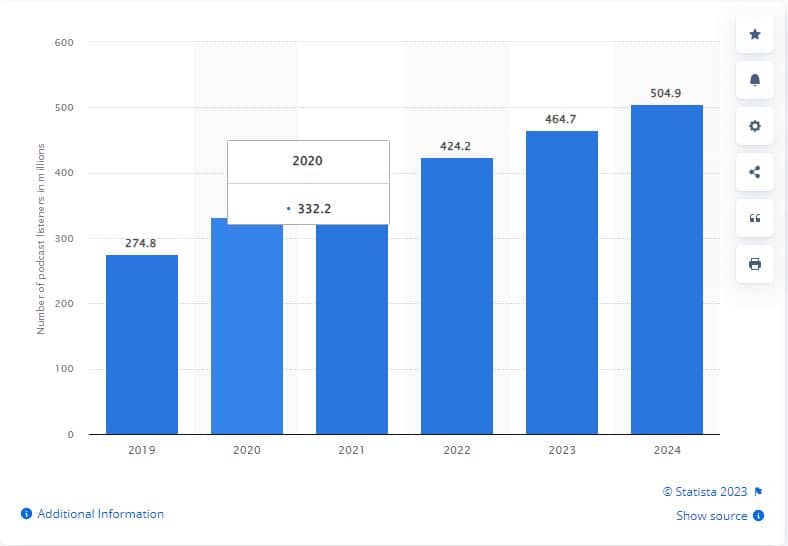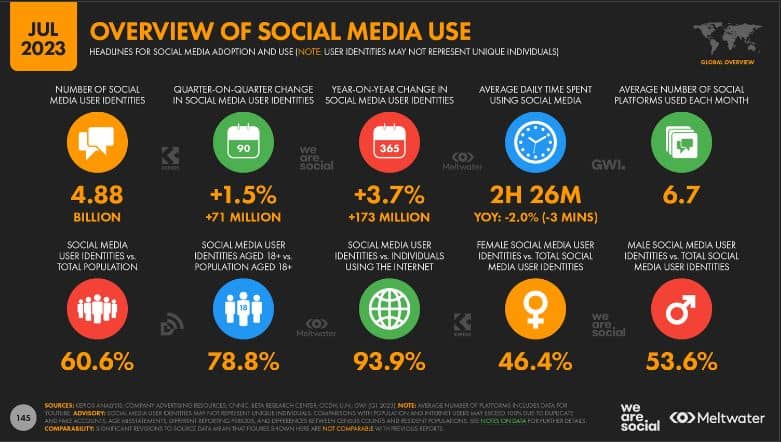Podcasting and Social Media: How To Integrate the Two Seamlessly

There’s magic in podcasting. Podcasts allow experts to educate others, help entrepreneurs boost their brands, and aid marketers in promoting products or services.
However, the magic grows when you leverage podcasts as part of your social media marketing strategies. Doing so lets you achieve the following objectives:
- Expand your reach.
- Boost your online presence.
- Enhance your engagement.
- Build an online community.
- Foster customer loyalty.
- Increase leads and sales.
But how do you integrate podcasts with your social media? Read on to find out the answer to this crucial question.
How To Integrate Podcast with Your Social Media
Did you know that the number of podcast listeners worldwide has been growing? Statista reported that the number had increased from 332.2 million internet users to 383.7 in 2021. It’s projected to reach $464.7 million this year and 504.9 million in 2024.

Meanwhile, it’s no secret how social media is powerful in today’s business landscape. It has nearly 4.9 billion users worldwide, accounting for over 60% of the global population. Leveraging channels like Facebook, Instagram, TikTok, and LinkedIn can work wonders for your business.

But what about combining podcasting and social media? That can provide your business with several opportunities, from customer engagement to lead generation to sales conversion.
Fret not; we’ll help you seamlessly integrate your podcasts with your social media. Ready to get started? Here’s how:
1. Share Your Podcasts on Facebook and LinkedIn
Of course, the first thing to do is post your podcasts on platforms like Facebook and LinkedIn. They shouldn’t only be sitting on your podcast channels, whether Spotify, Stitcher, or Apple Podcasts. Whether video or audio clips, they should also take space on social media.
Sharing podcasts on social media lets you reach a wide range of audiences. How? Since people live and breathe on these channels, you can target your podcasts to the right market. Therefore, this strategy should be a part of your Facebook and LinkedIn marketing tactics.
2. Create a YouTube Channel or Post Short Video Clips on TikTok
It’s easy to see people share their podcasts on the most popular social media channels for video engagement: YouTube and TikTok. For example, those looking to learn ancient languages like old English can subscribe to a YouTube channel or follow a TikTok page.
If you’ve been podcasting for quite some time, consider creating a YouTube channel. However, the trick of the trade is to post videos of your podcasts consistently. On the other hand, create short-form clips of your podcasts and post them on TikTok. Who knows? You might gain a huge following on these channels!
3. Publish Quote Cards from Podcasts on Instagram
Podcasts and Instagram appear to be irrelevant to each other. While podcasts are in the form of video or audio clips, Instagram usually houses visual content like product photos. However, you can collect quotable lines from your podcasts and post quote cards on your Instagram. What a great idea!
Alex Milligan, Co-founder & CMO of NuggMD, sees the potential of Instagram for brand promotion. “Many brands use this platform to share images of their products or services. However, you can also share quotable quotes that will boost your brand and resonate with your target audience.”
4. Share Behind-the-scenes Videos and Photos

Podcasting is a great way to brainstorm ideas with experts and share insights with others. It’s a platform for informing, educating, and inspiring people. However, most people value authenticity and relatability in today’s digital landscape.
So what better way to achieve these values than to create and share behind-the-scenes (BTS) of your podcasts? Try video editing to produce compelling BTS clips and employ photography to create striking images. Then, post them on your social media channels to show the rawness and realness of your podcasts.
5. Produce and Post Video Teasers on Social Media
Business experts and digital marketers usually hold podcasts and share them on social media thereafter. But why not take it the other way around? Create engaging short videos for your social media pages. These videos will serve as teasers of your upcoming podcasts.
This strategy is a viable solution for attracting audiences to your podcasts. However, consider the best times to post on TikTok or YouTube to be visible to your target people. Also, make your clips intriguing and enticing but clear and concise. Ultimately, you’ve got to be strategic with your approach to this.
6. Respond to Comments and Messages Related to Your Podcast
In this blog, we’ve shared many times how to create and post various content pieces on different social media channels. However, your social media marketing tactics for promoting your podcasts won’t matter if you don’t engage with your audiences.
Tom Golubovich, Head of Marketing & Media Relations at Ninja Transfers, suggests taking the time to interact. “This means responding to their comments and messages. Be prompt in answering their questions, processing their requests, and addressing their concerns. Your podcasts will make more sense if you engage with your audiences on social media.”
7. Invite Influencers and Their Followers to Your Podcast
The extreme popularity of social media has led to the rise of influencers. In fact, businesses partner with these social media influencers to promote their brands and reach out to an expanded market. That’s where the influencer marketing campaign enters the picture.
Jerry Han, CMO at PrizeRebel, recommends inviting influencers to your podcast. “As established authority figures, these influencers already have a huge following. It’s a good idea to tap into their expertise, allowing them to share what they know on your podcast. Not only will they promote your brands on their social media, but they will also help you gain new audiences.”
8. Encourage Followers to Create User-generated Content (UGC)
As the name suggests, user-generated content is brand-related content generated not by the company itself but by the customers. These customers willingly promote your brand without being paid or told to do so. So, when hosting a podcast, encourage your audiences to share what they learn and post UGC on their social media.
Jay (Yong Jia) Xiao, the Co-founder and President of SuretyNow, believes in the power UGC holds. “When customers create content promoting your brand, this means they are happy and satisfied with your products or services. And when they share it with others, people will most likely believe in them and patronize your brand.”
Final Words
There’s no denying the power of podcasting and social media in business. Combining the two can further unleash their full potential. Such an integration can provide plenty of business opportunities, from online visibility and customer engagement to lead generation and sales conversion.
As such, consider the tips and steps above for integrating podcasts with your social media channels.
Start by posting and sharing your podcasts on your Facebook, Instagram, YouTube, TikTok, and LinkedIn. Take advantage of these channels to promote these podcasts. Capitalize on this integration to reach a wider audience and engage with them. Ultimately, you’ll build an online community of loyal supporters!
FAQ
What role does social media play in podcasting? Social media serves as a crucial platform for promoting podcasts, engaging listeners, and expanding reach. It allows podcasters to share episode updates, interact with their audience, and create a community around their content.
How can podcasters effectively promote their episodes on social media? Podcasters can promote their episodes on social media by sharing intriguing snippets, quotes, or audiograms from episodes. Regular posting schedules and using relevant hashtags can also increase visibility and listener engagement.
What are the best social media platforms for podcast promotion? The best social media platforms for podcast promotion typically include Instagram, Twitter, and Facebook due to their large user bases and multimedia support. LinkedIn can also be effective for business and professional development podcasts.
How can podcasters use Instagram to grow their podcast audience? Podcasters can use Instagram to post behind-the-scenes content, episode teasers, and guest introductions. Utilizing Stories and IGTV for longer clips and engaging with followers through comments and polls can also be highly effective.
What are some tips for creating engaging content on social media for podcasts? Engaging content can include interactive posts such as polls, question sessions, or live discussions. Highlighting key insights, sharing guest profiles, and creating themed content series can keep the audience interested and returning.
How can Twitter be used to enhance a podcast’s social media presence? Twitter is ideal for real-time engagement and sharing quick episode highlights or relevant news links. Hosting Twitter chats with listeners or guests can foster a strong sense of community and keep the conversation going.
Can social media feedback influence podcast content? Absolutely, social media feedback can provide valuable insights into what listeners like or dislike, helping podcasters tailor content to audience preferences. Engaging with comments and suggestions can also make listeners feel valued and part of the podcast’s community.
How often should podcasters post on social media? Podcasters should aim to post regularly but not overwhelmingly. A balanced approach might include daily updates, with specific posts for episode releases, throwback episodes, and community engagement activities.
What tools can help manage social media for podcasters? Tools like Buffer, Hootsuite, or Later can help podcasters schedule and manage posts across multiple social media platforms efficiently. These tools also provide analytics to track engagement and audience growth.
How can live streaming on social media benefit podcasters? Live streaming episodes or discussions on platforms like Facebook Live or Instagram can increase real-time interaction and engagement. It also adds a visual element to the audio content, making it more dynamic and accessible.
What strategies can podcasters use to convert social media followers into podcast subscribers? Strategies include clear calls-to-action in posts, exclusive content for social media followers, or previews of upcoming episodes. Linking directly to podcast episodes or subscription pages makes it easy for followers to listen and subscribe.
Create more and better content
Check out the following resources and Grow!